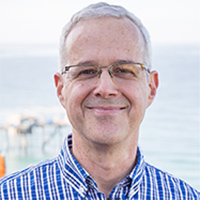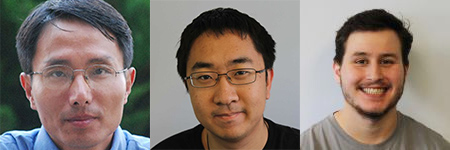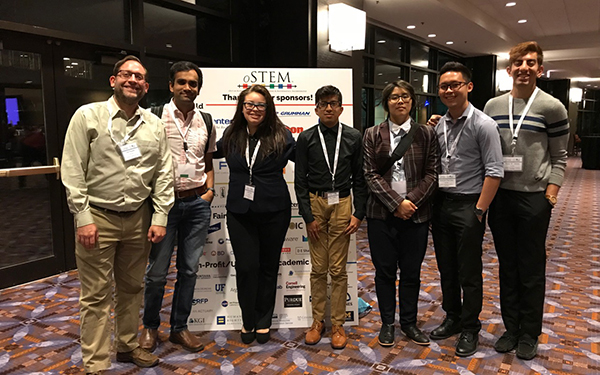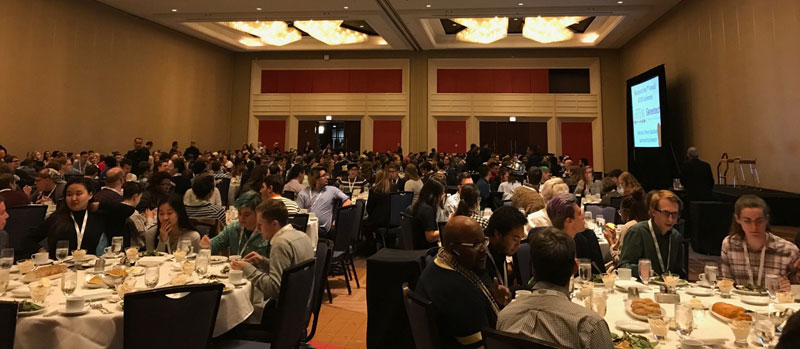
December 19, 2017
Strong CSE Presence at Top Machine Learning Conference
The 31st Annual Conference on Neural Information Processing Systems (NIPS) took place December 4-9 in Long Beach, CA. NIPS is the largest annual machine learning conference, and this year it attracted nearly 8,000 attendees, including a delegation from the Computer Science and Engineering (CSE) and other departments at the University of California San Diego.

“Historically, UC San Diego has always had a strong presence at NIPS,” said CSE professor Kamalika Chaudhuri, who had multiple papers and talks at NIPS 2017. “Every year we have quite a few papers, and a couple of years ago, the best paper award went to a team from UC San Diego.”
At NIPS 2015, top honors went to Electrical and Computer Engineering (ECE) professor Alon Orlitsky and his then-Ph.D. student Ananda Theertha Suresh for their paper on “Competitive Distribution Estimation: Why Is Good-Turing Good.” Orlitsky has dual appointments in ECE and CSE, and UC San Diego alumnus Suresh is now a research scientist at Google Research in New York.
NIPS 2017 Tutorial

CSE postdoc Anand Sarwate (now a professor
at Rutgers University)
UC San Diego’s presence at NIPS 2017 included a tutorial on “Differentially Private Machine Learning: Theory, Algorithms and Applications.” The tutorial was taught by CSE professor Kamalika Chaudhuri and Rutgers University professor Anand Sarwate (who was a postdoctoral researcher in UC San Diego’s Information Theory and Applications Center (ITA) prior to joining the Rutgers faculty).
Chaudhuri and Sarwate have posted their NIPS 2017 tutorial slides online. In this tutorial, Chaudhuri and Sarwate described the “basic framework of differential privacy [DP], key mechanisms for guaranteeing privacy, and how to find differentially private approximations to several contemporary machine learning tools,” notably convex optimization, Bayesian methods, and deep learning. Among the final takeaways cited by Chaudhuri and Sarwate: DP measures the risk incurred by algorithms operating on private data; “commonly-used tools in machine learning can be made differentially private; and accounting for total privacy loss can enable more complex private algorithms.”
Papers with UC San Diego Authors
Professor Chaudhuri was the senior author on two papers accepted to the main research track at NIPS 2017. She co-authored “Renyi Differential Privacy Mechanisms for Posterior Sampling” with CSE Ph.D. students Joseph Geumlek and Shuang Song.
She also co-authored “Approximation and Convergence Properties of Generative Adversarial Learning” with Chaudhuri’s Ph.D. student Shuang Liu and Google’s Olivier Bousquet.
Chaudhuri’s CSE Ph.D. student Songbai Yan collaborated with recent CSE alumnus Chicheng Zhang (Ph.D. ’17) for a paper on “Revisiting Perceptron: Efficient and Label-Optimal Learning of Halfspaces.” Zhang is currently a postdoctoral scholar at Microsoft Research in New York City.

Manmohan Chandraker
Another CSE professor, Manmohan Chandraker, was senior author on a paper with collaborators from University of Missouri (Guobin Chen and Tony Han) and NEC Laboratories (Wongun Choi and Xiang Yu). Their joint paper was titled “Learning Efficient Object Detection Models with Knowledge Distillation.”
A CSE postdoctoral researcher, Raef Bassily – part of the Data Science Postdoctoral Scholars program in the Information Theory and Applications Center (ITA) – co-authored a paper on “Practical Locally Private Heavy Hitters” prior to leaving UC San Diego for a faculty position at The Ohio State University. His co-authors on the paper were from Georgetown (Kobbi Nissim), Harvard (Uri Stemmer) and Apple (Abhradeep Thakurta).
Apart from NIPS papers involving faculty or students from CSE, several papers at NIPS 2017 involved faculty and students from another department in the Jacobs School of Engineering.

Alon Orlitsky
ECE professor Alon Orlitsky has a secondary faculty appointment in the CSE department – and he was the senior author on two papers at this year’s NIPS conference. In both cases, most of his co-authors are Ph.D. students in ECE. His paper on “Maxing and Ranking with Few Assumptions” was co-authored by ECE Ph.D. students Venkatadheeraj Pichapati, Vaishakh Ravindrakumar, Moein Falahalgar and Yi Hao.
Orlitsky also co-authored a paper on “The Power of Absolute Discounting: All-Dimensional Distribution Estimation” with ECE’s Falahatgar and Pichapati along with Mesrob Ohannessian from the Toyota Technological Institute at Chicago.

students Long Jin and Justin Lazarow
A Cognitive Science professor, Zhuowen Tu, who also has a faculty appointment in CSE, co-authored a paper with two CSE Ph.D. students, Long Jin and Justin Lazarow (M.S. ’17). Their paper focused on “Introspective Classification with Convolutional Nets.” Professor Tu is also a member of the Jacobs School’s interdisciplinary Center for Visual Computing.
Finally, one paper accepted for presentation in the main track at NIPS 2017 was co-authored by a professor with no connection to CSE or the Jacobs School. Psychology associate professor Edward Vul, who works at the intersection of computational and algorithmic descriptions of human cognition, co-authored a paper on “A Simple Model of Recognition and Recall Memory.” His co-author was IIT Kanpur professor Nisheeth Srivastava, who previously worked as a postdoctoral scholar in the lab of Psychology’s Vul.
Workshop Talks and Papers
UC San Diego also had a presence in workshops co-located with NIPS 2017. Professor Chaudhuri also delivered two invited talks at NIPS 2017 co-located workshops. One was delivered at the Dec. 8 day-long Workshop on Nearest Neighbors for Modern Applications with Massive Data. Her talk, based on a joint paper with third-year CSE Ph.D. student Yizhen Wang and Somesh Jha from the University of Wisconsin-Madison, focused on “Analyzing Robustness of Nearest Neighbors to Adversarial Examples.” According to Chaudhuri, there is an overall lack of general understanding about the foundations of designing machine learning algorithms robust to adversarial examples. “We take a step towards addressing this challenging question by introducing a new theoretical framework, analogous to bias-variance theory, which we can use to tease out the causes of vulnerability,” she noted. “We apply our framework to a simple classification algorithm: nearest neighbors, and analyze its robustness to adversarial examples.” Chaudhuri also proposed a modified version of the nearest neighbor algorithm, and demonstrated both theoretically and empirically that it has superior robustness to standard nearest neighbors.
Chaudhuri also delivered an invited talk on "Privacy-Preserving Mechanisms for Correlated Data," which was part of the Machine Learning and Computer Security Workshop (also co-located with NIPS 2017). It was one of three invited talks in the session on formal definitions and formal verification.

Songbai Yan
At another workshop, CSE Ph.D. student Songbai Yan collaborated with his co-advisors, CSE’s Chaudhuri and Electrical and Computer Engineering (ECE) professor Tara Javidi on a joint paper on, "Active Learning with Logged Bandit Feedback" that was part of the From What-If to What-Next Workshop. “Our goal is to learn a binary classifier that predicts labels with high accuracy on the entire population, not just the distribution of the logged data,” according to the paper’s abstract. “Previous work addresses this problem either when only logged data is available, or purely in a randomized experimentation setting.” The authors combined both approaches to provide an algorithm that uses logged data to bootstrap and inform experimentation, thus achieving the best of both worlds.
Next year’s NIPS conference will return to Montreal, Canada from December 3-8.
Computer Scientists Develop Tool to Detect Website
Data Breaches
Computer scientists have built and successfully tested a tool designed to detect when websites are hacked by monitoring the activity of email accounts associated with them. The researchers were surprised to find that almost 1 percent of the websites they tested had suffered a data breach during their 18-month study period, regardless of how big the companies' reach and audience are.
"No one is above this-companies or nation states- it's going to happen; it's just a question of when," said Alex C. Snoeren, the paper's senior author and a professor of computer science at the Jacobs School of Engineering at the University of California San Diego.

entire code is available on GitHub at:
https://github.com/ccied/tripwire/
One percent might not seem like much. But given that there are over a billion sites on the Internet, this means tens of millions of websites could be breached every year, said Joe DeBlasio, one of Snoeren's Ph.D. students and the paper's first author. Even scarier, the researchers found that popular sites were just as likely to be hacked as unpopular ones. This means that out of the top-1000 most visited sites on the Internet, ten are likely to be hacked every year.
"One percent of the really big shops getting owned is terrifying," DeBlasio said.
The team of researchers at UC San Diego presented the tool in November 2017 in a paper* at the ACM Internet Measurement Conference in London.
The concept behind the tool, called Tripwire, is relatively simple. DeBlasio created a bot that registers and creates accounts on a large number of websites-around 2,300 were included in their study. Each account is associated with a unique email address. The tool was designed to use the same password for the email account and the website account associated with that email. Researchers then waited to see if an outside party used the password to access the email account. This would indicate that the website's account information had been leaked.
To make sure that the breach was related to hacked websites and not the email provider or their own infrastructure, researchers set up a control group. It consisted of more than 100,000 email accounts they created with the same email provider used in the study. But computer scientists did not use the addresses to register on websites. None of these email accounts were accessed by hackers.
In the end, researchers determined 19 websites had been hacked, including a well-known American startup with more than 45 million active customers.
Once the accounts were breached, researchers got in touch with the sites' security teams to warn them of the breaches. They exchanged emails and phone calls. "I was heartened that the big sites we interacted with took us seriously," Snoeren said.
Yet none of the websites chose to disclose to their customers the breach the researchers had uncovered. "I was somewhat surprised no one acted on our results," Snoeren said.
The researchers decided not to name the companies in their study.
"The reality is that these companies didn't volunteer to be part of this study," Snoeren said. "By doing this, we've opened them up to huge financial and legal exposure. So we decided to put the onus on them to disclose."
Interestingly, very few of the breached accounts were used to send spam once they became vulnerable. Instead, the hackers usually just monitored email traffic. DeBlasio speculates that the hackers were monitoring emails to harvest valuable information, such as bank and credit card accounts.
Researchers went a step further. They created at least two accounts per website. One account had an "easy" password-strings of seven-character words with their first letter capitalized and followed by a single digit. These kinds of passwords are usually the first passwords that hackers will guess. The other account had a "hard" password-random 10-character strings of numbers and letters, both in lower and upper case, without special characters.
Seeing which of the two accounts got breached allowed researchers to make a good guess about how websites store passwords. If both the easy and hard passwords were hacked, the website likely just stores passwords in plain text, contrary to typically-followed best practice. If only the account using the easy password was breached, the sites likely used a more sophisticated method for password storage: an algorithm that turns passwords into a random string of data-with random information added to those strings.
The computer scientists had a few pieces of advice for Internet users: don't reuse passwords; use a password manager; and ask yourself how much you really need to disclose online.
"Websites ask for a lot of information," Snoeren said. "Why do they need to know your mother's real maiden name and the name of your dog?"
DeBlasio was less optimistic that these precautions would work. "The truth of the matter is that your information is going to get out; and you're not going to know that it got out," he said.
Snoeren and colleagues are not planning to pursue further research on Tripwire. "We hope to have impact through companies picking it up and using it themselves," he said. "Any major email provider can provide this service."
__________________________
*Paper: Joe DeBlasio, Stefan Savage, Geoffrey M. Voelker and Alex C. Snoeren, Tripwire: Inferring Internet Site Compromise, Proc. Internet Measurement Conference (IMC 2017), London, UK, November 2017.
New UC San Diego Chapter Sends LGBT+ Delegates to oSTEM Conference
For the first time, a delegation of faculty and students from the University of California San Diego attended the annual Out in Science, Technology, Engineering and Mathematics (oSTEM) National Conference. The four-day conference took place November 16-19 in Chicago, IL.
Over 800 attendees participated in the 7th oSTEM conference to discuss topics and challenges faced by members of the LGBT+ community in STEM fields (including computer science), and to celebrate the community and help ensure student success in school - and when those students start looking for a job.

nd undergraduate UC San Diego students Kayla Ortiz, Terry Worlikar,
Joyce (Jun) Lor, Sothyrak (Tee) Srey, and Hasan Al-Jamaly.
The national event coincided with the inaugural year of the new oSTEM Chapter at UC San Diego. Financial support from sponsors allowed the new chapter to send five undergraduate students to the conference: Kayla Ortiz, Terry Worlikar, Joyce (Jun) Lor, Sothyrak (Tee) Srey, and Hasan Al-Jamaly.
"Being part of the conference was an exhilarating experience that opened my eyes to a community I never knew existed," said Computer Science junior Hasan Al-Jamaly. "More importantly, it's a community I truly belong to and feel part of." Other attendees also reinforced the importance of solidarity with other oSTEM participants as an integral part of their experience at the conference.
Two UC San Diego faculty members accompanied the student delegation to Chicago: Computer Science and Engineering (CSE) professor Arun Kumar, and Mathematics professor Daniel Rogalski. UC San Diego faculty participation in the conference was made possible by campus units: CSE in the case of professor Kumar, and the Office of the Dean of Physical Sciences in the case of professor Rogalski.

The new oSTEM chapter at UC San Diego also benefited from support provided by corporate sponsors Northrop Grumman, Boeing and Door of Clubs (a startup that matches college clubs with potential partners in industry). Funding from UC San Diego academic units came from the Jacobs School of Engineering, Division of Biological Sciences, and Division of Physical Sciences. Aid was also forthcoming from the national oSTEM organization.
The conference featured an extensive span of corporate site tours, workshops, research presentations, networking opportunities, and a career and graduate student expo where oSTEM students could meet with potential future employers. In addition to sponsors Northrop Grumman and Boeing, organizations with booths this year included NASA, Raytheon, Google, Genentech, Accenture, Lockheed Martin, and the nonprofit Human Rights Campaign. A number of elite graduate programs also had booths, including Columbia Engineering, John Hopkins, Cornell Engineering, UC Berkeley, University of Michigan, New York University, Purdue, and Georgia Tech.
Topics on the agenda ranged from "Ending Police Violence with Artificial Intelligence," "An Introduction to Leadership: Motivating People to Believe and Achieve," community breakouts featuring Queer/Pan/Ace/Middle Sexualities, Faith, Trans/Non-Binary, as well as panels such as "It's Okay to Not Be Okay: Managing Your Mental Health," and "Dear White People: Intersection of Race/Ethnicity & LGBTQIA Identity."

booths at oSTEM to introduce undergrads to graduate
programs in engineering and other STEM fields.
During the conference, oSTEM also organized a Chapter Leadership Summit to discuss the fundamentals of executive board management, an issue that pervades many student organizations. A major topic at this year's summit was the open-mindedness necessary to run an infant organization, as well as effective planning and project management tools based on setting goals that are specific, measurable, attainable, relevant, and timely.
Computer Science senior Sothyrak (Tee) Srey -- current holder of the Center for Networked Systems (CNS) Alan Turing Memorial Scholarship at UCSD -- participated in the summit. "This is our first official year and our first time attending the oSTEM National Conference, and I was really hoping to leave the conference with concrete ideas that I could implement as an officer," said Srey, Secretary of the oSTEM chapter at UC San Diego. "After hearing from other chapters, I feel a sense of relief because of how well our chapter is doing so far. We typically draw about 30 people to oSTEM meetings at UC San Diego, which is roughly similar to the number of active participants at longer-established oSTEM chapters around the country. This shows that we are making an impact in LGBT visibility on campus."
According to CSE professor Arun Kumar, more UC San Diego LGBT+ faculty would benefit from establishing a community similar to the students' oSTEM chapter on campus. "There was almost no other faculty from computer science at the national conference this year," noted Kumar. "An organized network of LGBT+ faculty could promote useful community-building within academia."
Looking ahead to the 2018 8th oSTEM national conference, which will take place in Texas, the UC San Diego chapter is planning to send more students and faculty than they did this year.
Professors Kumar and Rogalski leveraged their presence at oSTEM 2017 to collect relevant information from staff and students from other schools with booths or other presence at the conference -- information that could guide UC San Diego as it ramps up its presence at the 2018 conference. CSE's Kumar believes UC San Diego should be able to join the ranks of graduate schools with booths at the oSTEM expo next year in Texas. A UC San Diego booth would particularly focus on recruiting future graduate students in STEM topics from among the ranks of oSTEM's (mostly) undergraduate student delegates. (Assuming that support is forthcoming from graduate schools and divisions at UC San Diego, the oSTEM chapter would staff a booth to hand out graduate-school materials and represent the graduate divisions and schools to encourage greater diversity throughout UC San Diego.)
"Overall, UC San Diego's participation in its first oSTEM national conference was a great success," added student Tee Srey. "It proved to be beneficial in enabling our oSTEM chapter's ability to continue building community - and enabling our members to succeed."
The growing presence of UC San Diego at future oSTEM events reflects the greater awareness on campus of the need to attract and retain a diverse student body, especially in technology and the sciences. Last June a 2017 report by College Choice named UC San Diego the 9th best public university in the U.S. for LGBTQ students, and 19th among all public and private universities for LGBTQ students.
7th Annual oSTEM National Conference
UC San Diego oSTEM Chapter on Facebook
Company Based on CSE Technology Gets Infusion
of Capital
A company co-founded by CSE professor and Qualcomm Institute academic participant Ryan Kastner and two CSE alumni is now positioned for new growth thanks to an infusion of capital from a venture-capital firm. The hardware security company Tortuga Logic just reported receiving $2 million in seed funding, all of it coming from Eclipse Ventures to accelerate engineering efforts and expand sales and marketing.

CSE professor Ryan Kastner is a co-founder and sits on the company's
Advisory Board; and UC Santa Barbara professor Tim Sherwood earned
his Ph.D. in Computer Science from UC San Diego in 2013.
Tortuga Logic offers a suite of hardware design tools to identify security vulnerabilities throughout the process of designing a semiconductor, including Prospect and Unison (used in the semiconductor, aerospace and defense industries). With its new funding, Tortuga Logic will develop new products and increase the feature sets of existing products.
The company's co-founder and CEO Jason Oberg (M.S., Ph.D. '12, '14) also announced on Dec. 14 the hiring of a new VP of Engineering, Andrew Dauman. "We are seeing a huge paradigm shift in cybersecurity," said Oberg, who co-founded the company while still a Ph.D. student in CSE. "Existing software-based cybersecurity companies address software vulnerabilities but overlook hardware. With a round of seed funding and Andrew Dauman's leadership, we are fully prepared to take on the challenge of eliminating hardware vulnerabilities."

Tortuga Logic's technology, based on previous research carried out in the lab of CSE professor Kastner at UC San Diego, identifies and prevents security vulnerabilities in system-on-chip (SoC) designs. Its patented technology augments industry-standard verification tools to enable a secure development lifecycle.
The company was co-founded by experts and pioneers in the hardware security space. In addition to UC San Diego's Kastner and CEO Oberg, Tortuga Logic's co-founders also include UC Santa Barbara computer-science professor Tim Sherwood, who is also a CSE alumnus (M.S., Ph.D. '03), and his former student, Chief Operating Officer Jonathan Valamehr, who earned all of his degrees from UC Santa Barbara.
Tortuga Logic's products fill a gap between the intent of security IP building blocks and their actual deployment in full SoC designs. "Without these products, chips will continue to be built in ways that leave them vulnerable to hackers," said new VP Dauman. "Our goal is to ensure the chip's final implementation does not expose a security hole that software will exploit."
First-Year CSE Undergrads Program, Design and Build Robots

the CSE/UC-TV Computer Science Channel
CSE professor Steven Swanson has developed new hands-on courses in the past couple of years for first- and second-year undergraduates who are interested in computer engineering and computer science.
The new curriculum includes a course that Swanson dubs "Robot Parade!" Previously known as CSE 91, the course is now CSE 42. which was offered for the first time in Fall 2017. The course gives students -- many in their first quarter at UC San Diego -- first-hand experience with designing, building and programming their own rudimentary robots.

robotics course for first-year undergraduates.
A video narrated by Swanson and featuring some of the final presentations and competition among students and robots in last year's course is now available for on-demand streaming through CSE's Computer Science Channel, a partnership between the department and University of California TV (see link in caption below).
As CSE 91, the course was called "Designing and Building Robots." The updated course now has a more accurate moniker: "Building and Programming Electronic Devices." It is a 2-unit, pass-fail course. Students must apply to get into the course.
"CSE 42 lets students apply what they learn in an introductory programming course -- typically CSE 11 -- and make things happen in the real world," said Swanson. "The course is targeted at freshman students in engineering and science disciplines."
Working in teams, students first learn to program Arduino-based robots. The teams then design a custom robot of their own -- and program it to do whatever the students decide. Students also learn their way around the Jacobs School of Engineering's Envision Maker Studio, where they learn how to use 3D printers and other tools to help complete the robot's design.
CSE Holiday Party 2017... in Pictures
The Computer Science and Engineering department held its annual Holiday Party 2017, allowing students to take a break from study for final exams ahead of the break. Here are a few images from the festivities. To download full-resolution images, visit the Flickr page.

